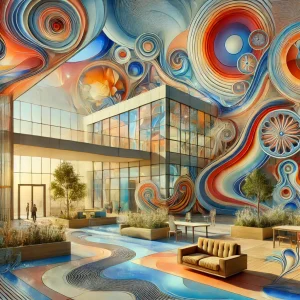 Kiyoshi Izumi, a groundbreaking Canadian architect, is celebrated for his innovative approach to the design of psychiatric wards in the mid-20th century. Central to his work was his collaboration with Dr. Humphrey Osmond, a British psychiatrist who was instrumental in the early exploration of psychedelics as therapeutic tools. Together, they sought to revolutionize psychiatric environments, moving away from the cold, institutional designs of the past towards spaces that promoted healing and well-being. Their partnership was deeply rooted in a shared belief that understanding altered states of consciousness—through the use of psychedelics—could inform more empathetic and effective designs for psychiatric facilities.
Kiyoshi Izumi, a groundbreaking Canadian architect, is celebrated for his innovative approach to the design of psychiatric wards in the mid-20th century. Central to his work was his collaboration with Dr. Humphrey Osmond, a British psychiatrist who was instrumental in the early exploration of psychedelics as therapeutic tools. Together, they sought to revolutionize psychiatric environments, moving away from the cold, institutional designs of the past towards spaces that promoted healing and well-being. Their partnership was deeply rooted in a shared belief that understanding altered states of consciousness—through the use of psychedelics—could inform more empathetic and effective designs for psychiatric facilities.
The Collaboration Between Izumi and Osmond
Kiyoshi Izumi and Humphrey Osmond first crossed paths in the 1950s, during a time when Osmond was conducting groundbreaking research into the therapeutic potential of psychedelics, particularly LSD and mescaline. Osmond was exploring these substances as tools to better understand the experiences of those with mental illnesses, and he coined the term “psychedelic” to describe their mind-expanding effects. Izumi, with his deep interest in creating more humane psychiatric environments, found a kindred spirit in Osmond.
Their collaboration was born out of a shared vision: to create psychiatric wards that would not only house patients but also contribute actively to their healing. Osmond believed that traditional psychiatric institutions were failing patients by ignoring the profound impact that environment could have on mental health. Izumi, inspired by this perspective, saw an opportunity to apply these insights directly to his architectural designs.
Using Psychedelics to Understand the Patient’s Experience
One of the most significant aspects of Izumi and Osmond’s collaboration was their shared use of psychedelics as a tool for design. Osmond introduced Izumi to the idea of using these substances to explore altered states of consciousness, which they believed could offer valuable insights into the experiences of psychiatric patients. By undergoing guided psychedelic experiences, Izumi aimed to gain a deeper understanding of the psychological challenges faced by those with mental illnesses.
For Izumi, these experiences were transformative. Under Osmond’s guidance, he explored the effects of psychedelics like LSD, which allowed him to experience reality in a way that might parallel the altered perceptions of psychiatric patients. This newfound perspective was invaluable in informing his architectural designs, as he sought to create spaces that were not only functional but also psychologically supportive.
Influence of Psychedelics on Design Principles
The insights gained from their psychedelic experiences had a profound impact on the design principles that Izumi and Osmond championed. They began to see the physical elements of space—such as light, color, and form—as integral to the psychological well-being of patients. Their designs moved away from the rigid, institutional architecture of the time, embracing instead concepts that prioritized fluidity, natural light, and open, inviting spaces.
Izumi and Osmond recognized that the environment could significantly influence a patient’s mood and perception. For example, they understood that natural light and organic shapes could help reduce anxiety and promote a sense of safety. This led to the incorporation of large windows, which allowed for abundant natural light and views of nature—elements that were previously rare in psychiatric facilities.
Color played a crucial role in their designs as well. The duo recognized that the color palette of a space could evoke specific emotional responses, and they carefully selected colors to create environments that were both calming and uplifting. Cool, soothing colors were used in patient rooms to foster relaxation, while warmer tones were employed in communal areas to encourage social interaction and engagement.
Case Study: The Weyburn Psychiatric Hospital
One of the most notable projects that emerged from the Izumi-Osmond collaboration was the redesign of the Weyburn Psychiatric Hospital in Saskatchewan, Canada. Osmond had been working at Weyburn since the early 1950s, conducting his research into the effects of psychedelics on the human mind. When Izumi joined him on the project, they set out to create a psychiatric facility that embodied their shared vision of a more humane and therapeutic environment.
The Weyburn Psychiatric Hospital redesign featured many of the elements that Izumi and Osmond had identified as crucial to patient well-being. The hospital was designed with open, airy spaces that allowed for natural light to permeate the building. The use of color was deliberate and thoughtful, with different hues used to evoke specific emotional responses in different areas of the facility.
Their work at Weyburn was groundbreaking, not just for the architectural innovations it introduced, but also for the way it integrated the psychological needs of patients into the very fabric of the building’s design. The hospital became a model for how psychiatric facilities could be designed to support mental health, rather than merely containing patients.
The Legacy of Izumi and Osmond’s Work
The partnership between Kiyoshi Izumi and Humphrey Osmond left an indelible mark on the fields of architecture and mental health care. Their collaboration demonstrated the power of interdisciplinary approaches to solving complex problems and highlighted the potential of unconventional methods—like the use of psychedelics—to yield profound insights.
Today, the influence of their work can be seen in modern psychiatric facilities that prioritize natural light, open spaces, and the use of color to create environments that support healing. The legacy of Izumi and Osmond is a testament to the importance of empathy and innovation in design, and to the enduring impact of their shared vision for more humane psychiatric care.
The collaboration between Kiyoshi Izumi and Humphrey Osmond stands as a unique and pioneering chapter in the history of architecture and mental health care. By daring to explore altered states of consciousness through psychedelics, they were able to gain insights that informed their revolutionary approach to the design of psychiatric wards. Their legacy continues to inspire those who seek to create environments that heal both the body and the mind, and their work serves as a reminder of the transformative power of empathy and innovation in design.




